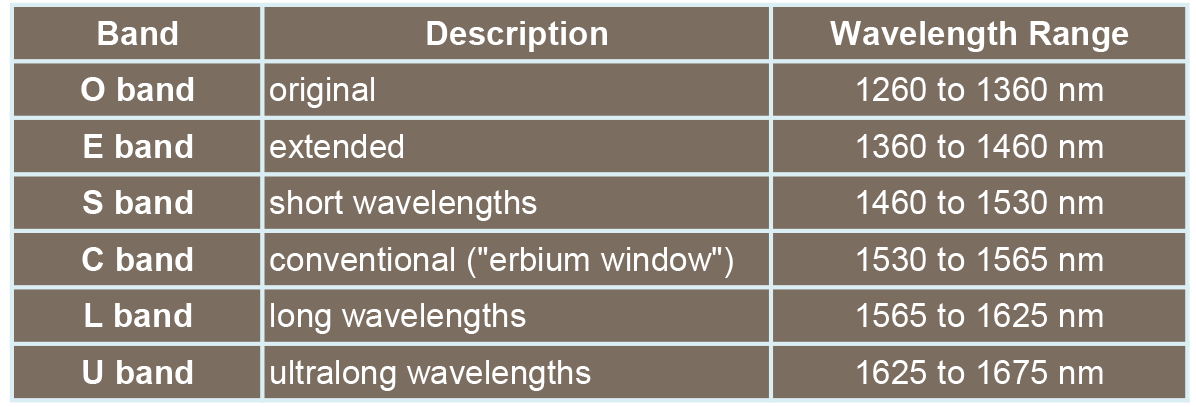To provide a very high capacity for optical transmission systems, it is desirable to allow as wide a range as possible for the system operating wavelengths. The choice of operating wavelength range depends on several factors, including fiber type, source characteristics, system attenuation range, and dispersion of the optical path.
ITU Frequency Bands in WDM Systems
“Grids” are used for location of nominal central frequencies in WDM systems. The International Telecommunications Union (ITU) has divided the telecom wavelengths into a ITU frequency grid; the grid is divided into bands. The following are ITU frequency bands for single-mode fiber systems:

“Original” O-band, 1260 nm to 1360 nm
The lower limit is determined by the cable cut-off wavelength, which is 1260 nm. The upper limit 1360 nm is determined by the rising edge of the “water” attenuation band peaked at 1383 nm, so 1360 nm was chosen as the upper limit.
“Extended” E-band, 1360 nm to 1460 nm
Fibers with a low water attenuation peak allows the utilization of the band above 1360. The effects of a small water peak are negligible at wavelengths beyond about 1460 nm.
“Conventional” C-band, 1530 nm to 1565 nm
Initially, erbium-doped fiber amplifiers (EDFAs) had useful gain bands beginning at about 1530 nm and ending at about 1565 nm. This gain band had become known as the “C-band”.
“Short wavelength” S-band, 1460 nm to 1530 nm
The lower limit of this band is taken to be the upper limit of the E-band. The upper limit is taken to be the lower limit of the C-band. EDFAs have become available with relatively flatter and wider gains and application of EDFAs to this band is possible at least in a part of the band. Some wavelengths of this band may also be utilized for pumping of optical fiber amplifiers, both of the active-ion type and the Raman type.
“Long wavelength” L-band, 1565 nm to 1625 nm
For the longest wavelengths above the C-band, fiber cable performance over a range of temperatures is adequate up to 1625 nm for current fiber types.
“Ultra-long wavelength” U-band, 1625 nm to 1675 nm
In some cases it is desirable to perform a number of maintenance functions (preventive, after installation, before service and post-fault) on fiber cables in the outside plant. These involve surveillance, testing, and control activities utilizing optical time domain reflectometer (OTDR) testing, fiber identification, loss testing, and power monitoring. A wavelength region, that is intended to be never occupied by transmission channels, may be attractive for maintenance, even if enhanced loss occurs. The U-band has been defined exclusively for possible maintenance purposes. Transmission of traffic-bearing signals is not currently foreseen in this band. The use for non-transmission purposes must be done on a basis of causing negligible interference to transmission signals in other bands. Sufficiently low fiber loss is not ensured in this band.
ITU Frequency Bands Summarization

Click the following link to learn more and Discover the Fiber-optic World.